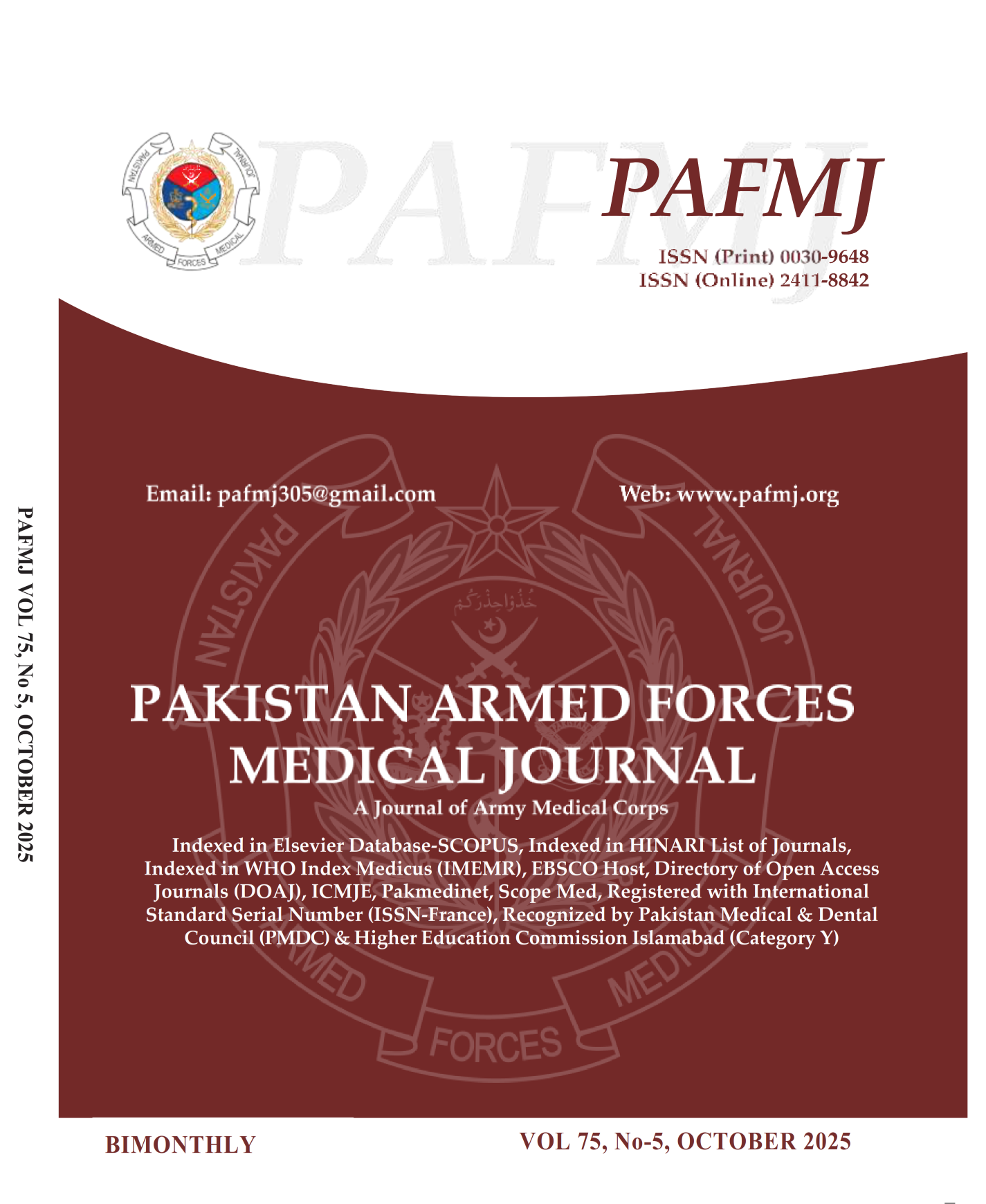Correlation of Electroencephalography (EEG) Findings with Clinical Seizures in Children
DOI:
https://doi.org/10.51253/pafmj.v75i5.9954Keywords:
Electroencephalogram, Epilepsy, Paediatric Patients, Recurrent SeizuresAbstract
Objective: To determine the sensitivity, specificity and diagnostic accuracy of electroencephalography in predicting the development of a second/recurrent seizures/epilepsy within one year of first attack, in children who have developed their first unprovoked seizure.
Study Design: Cross-sectional validation study.
Place and Duration of Study: Department of Paediatrics, Combined Military Hospital, Rawalpindi, Pakistan from Jan to Dec 2022.
Methodology: This study was conducted on 126 paediatric patients who reported with a first unprovoked seizure. All patients aged between 4 and 12 years, of both genders. All participants underwent the recording of an EEG, for thirty minutes with photic and hyperventilation stimulation. All patients were followed-up for a period of one-year.
Results: Mean time from onset of seizure to presentation was 22.89±13.37 hours. An abnormal EEG was seen in 57(45.2%) patients: seizure activity was seen in 11(8.7%) cases, focal and generalized spike-waves in 11(8.7%) and 10(7.9%) cases, respectively, while slowing was seen in 31(24.6%) cases. Seizure recurrence was seen in 66(52.4%) cases. An abnormal EEG as a predictor for the development of recurrent seizures/epilepsy in children, who have had their first episode of unprovoked seizure, had a sensitivity of 57.58%, a specificity of 68.33%, a positive predictive value of 66.67%, a negative predictive value of 59.42% and a diagnostic accuracy of 62.70%.
Conclusion: Electroencephalographic findings alone in paediatric patients suffering from their first unprovoked seizure carries inadequate sensitivity, specificity and diagnostic accuracy in predicting the development of future seizures.
Downloads
References
1 Klotz KA, Sag Y, Schönberger J, Jacobs J. Scalp Ripples Can Predict Development of Epilepsy After First Unprovoked Seizure in Childhood. Ann Neurol 2021; 89(1): 134-142.
https://doi.org/10.1002/ana.25939
2 De Rezende-Machado M, Bruck I, De Paola L, Cat MN, Antoniuk SA, Silvado CES et al. The First Unprovoked Seizure in Typically Developing Children: A Real-Life Setting in Southern Brazil. Clin EEG Neurosci 2021; 52(6): 455-461.
https://doi.org/10.1177/1550059420965391
3 Rehman ZU. Clinical Characteristics and Etiology of Epilepsy in Children Aged Below Two Years: Perspective From a Tertiary Childcare Hospital in South Punjab, Pakistan. Cureus 2022; 14(4): e23854.
https://doi.org/10.7759/cureus.23854
4 Minardi C, Minacapelli R, Valastro P, Vasile F, Pitino S, Pavone P, et al. Epilepsy in Children: From Diagnosis to Treatment with Focus on Emergency. J Clin Med 2019; 8(1): 39.
https://doi.org/10.3390/jcm8010039
5 Smith SJ. EEG in the diagnosis, classification, and management of patients with epilepsy. J Neurol Neurosurg Psychiatry 2005; 76(Suppl 2): ii2-ii7.
6 Biasiucci A, Franceschiello B, Murray MM. Electroencephalography. Curr Biol 2019; 29(3): R80-R85.
https://doi.org/10.1016/j.cub.2018.11.052
7 Ayele BA, Belay HD, Oda DM, Gelan YD, Negash HA, Kifelew S, et al. Electroencephalographic Findings, Antiepileptic Drugs and Risk Factors of 433 Individuals Referred to a Tertiary Care Hospital in Ethiopia. Ethiop J Health Sci 2022; 32(5): 905-912.
https://doi.org/10.4314/ejhs.v32i5.5
8 Antony AR, Haneef Z. Systematic review of EEG findings in 617 patients diagnosed with COVID-19. Seizure 2020; 83(1): 234-241.
https://doi.org/10.1016/j.seizure.2020.10.014
9 Chen H, Koubeissi M, Aziz S, Slater JD, Al Bunni H, Khan MT, et al. Seizure symptoms and ambulatory EEG findings: incidence of epileptiform discharges. Epileptic Disord 2020; 22(6): 752-758.
https://doi.org/10.1684/epd.2020.1220
10 Benbadis SR, Beniczky S, Bertram E, MacIver S, Moshé SL. The role of EEG in patients with suspected epilepsy. Epileptic Disord 2020; 22(2): 143-155.
https://doi.org/10.1684/epd.2020.1151
11 Bouma HK, Labos C, Gore GC, Wolfson C, Keezer MR. The diagnostic accuracy of routine electroencephalography after a first unprovoked seizure. Eur J Neurol 2016; 23(3): 455-463.
https://doi.org/10.1111/ene.12739
12 Hernández-Ronquillo L, Thorpe L, Dash D, Hussein T, Hunter G, Waterhouse K, et al. Diagnostic Accuracy of the Ambulatory EEG vs. Routine EEG for First Single Unprovoked Seizures and Seizure Recurrence: The DX-Seizure Study. Front Neurol 2020; 11(1): 223.
https://doi.org/10.3389/fneur.2020.00223
13 De Rezende-Machado M, Bruck I, de Paola L, Cat MN, Antoniuk SA, Silvado CE et al. The First Unprovoked Seizure in Typically Developing Children: A Real-Life Setting in Southern Brazil. Clin EEG Neurosci 2021; 52(6): 455-461.
https://doi.org/10.1177/1550059420965391
14 Crevier-Sorbo G, Brunette-Clément T, Medawar E, Mathieu F, Morgan BR, Hachem L, et al. Assessment and treatment of childhood epilepsy in Haiti. Epilepsia Open 2020; 5(2): 190-197.
https://doi.org/10.1002/epi4.12384
15 Khan A, Lim H, Almubarak S. Importance of prompt diagnosis in pediatric epilepsy outcomes. Seizure 2020; 80(1): 24-30.
https://doi.org/10.1016/j.seizure.2020.03.011
16 Hu Y, Shan Y, Du Q, Ding Y, Shen C, Wang S, et al. Gender and Socioeconomic Disparities in Global Burden of Epilepsy: An Analysis of Time Trends From 1990 to 2017. Front Neurol 2021; 12: 643450. https://doi.org/10.3389/fneur.2021.643450
17 Reddy DS, Thompson W, Calderara G. Molecular mechanisms of sex differences in epilepsy and seizure susceptibility in chemical, genetic and acquired epileptogenesis. Neurosci Lett 2021; 750(1): 135753.
https://doi.org/10.1016/j.neulet.2021.135753
18 Al-Momani MA, Al-Momani B, Hani SB, Lux A. Recurrence of First Afebrile Unprovoked Seizure and Parental Consanguinity: A Hospital-Based Study. J Child Neurol 2020; 35(10): 643-648.
https://doi.org/10.1177/0883073820924484
19 Pellino G, Faggioli R, Madrassi L, Falsaperla R, Suppiej A. Operational diagnosis of epilepsy in children at undetermined risk: A meta-analysis of prognostic factors for seizure recurrence. Epilepsy Behav 2022; 127(1): 108498.
https://doi.org/10.1016/j.yebeh.2021.108498
20 Chowdhury AH, Chowdhury RN, Khan SU, Ghose SK, Wazib A, Alam I, et al. Sensitivity and specificity of electroencephalography (EEG) among patients referred to an electrophysiology lab in Bangladesh. J Dhaka Med Coll 2014; 23(2): 215-222.
Downloads
Published
Issue
Section
License
Copyright (c) 2025 Bilal Akhlaq, Ehsan Qadir, Hafsa Arshad, Awais Kazmi, Farooq Ikram, Syed Hassan Nawaz

This work is licensed under a Creative Commons Attribution-NonCommercial 4.0 International License.















